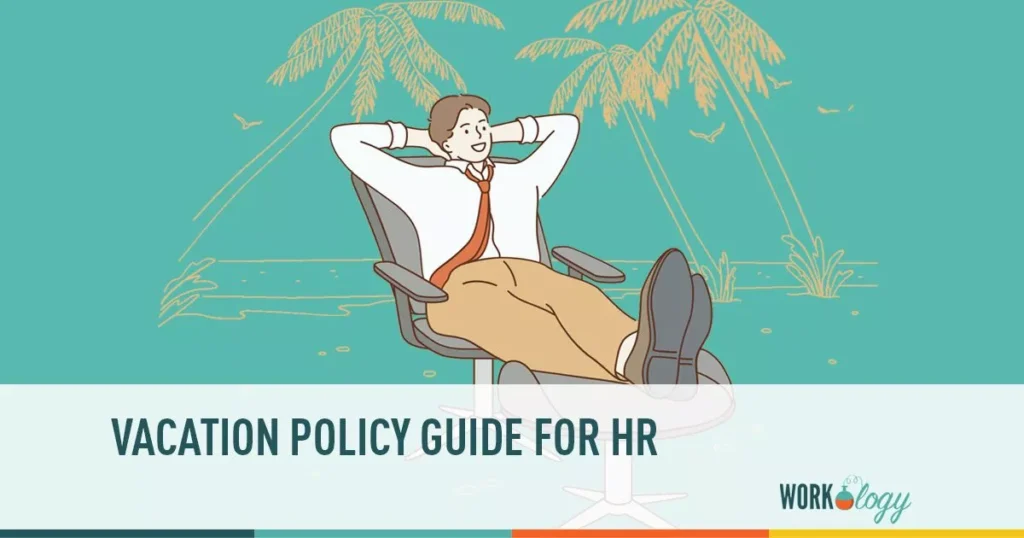Every employee needs a vacation now and then. Whether it’s a two-week trip to the Bahamas or a day off for mental health, it’s incredibly important to have a consistent vacation policy in your handbook so your employees can have some well-deserved rest. A solid vacation policy is a huge way to make sure your employees feel valued and supported!
Vacation Policy Guide for HR
There are many types of paid leave that HR should know about, but what is vacation time in the workplace, and what policies should it have? Should it be paid? How does it accrue? And what’s the difference between a vacation and other forms of leave?
I’ll give you all the details on what some templates for vacation policies look like, as well as some examples.
Vacation Time Basics
Vacations are usually reserved for full-time employees to take time off from work for a reason other than being sick. They won’t have to work for the time they take off, and they’ll still get paid the same amount they would have made if they had worked that day.
Companies handle their vacation policy handbooks in different ways since federal law doesn’t require an employer to provide any amount of vacation pay. But that doesn’t mean you shouldn’t provide one! A 2020 report from Pew Research found that paid time off is considered a benefit that most employers offer, with 91 percent of employers with 500 or more employees offering some form of paid time off as a benefit to their employees. So, if you don’t offer paid vacation time, it can impede your ability to attract and retain talent.
How To Assemble the Perfect Vacation Policy
In order to plan the best vacation policy, you’ll have to juggle what’s best for the company and what’s best for the employees. Here’s what you’ll have to make decisions on:
Sick Time vs. Vacation Time
Some companies put sick time and vacation time into one category, giving employees just one bulk number of days to be used for both purposes. Other companies separate sick time and vacation time, and employees can pull days out of each pool separately to use them.
Bulk or Accrued Vacation Time?
Employers sometimes give employees a bulk amount of vacation time depending on how long they’ve worked there (for example, 10 business days for someone who’s worked at a company for 1-5 years).
Alternatively, some employers will have their employees accrue vacation hours over a set period. Employees can accrue vacation time either per pay period (every 2 weeks they’ll get so many hours) or per year (every year they’ll get 21 days).
Unused Vacation Days?
It’s common for a company to reset employees’ vacation time at the beginning of each new year. However, some companies will let their employees roll over their vacation days, and even pay them for their unused days in their final paycheck.
Vacation Policy Examples
I’ve given you a lot to think about, but it’s always better to see some examples:
All full-time employees at [Company] are eligible for our paid vacation plan. Vacation time can be used for any personal matters aside from sick time, which is included separately in our paid time off policy.
Employees will accrue vacation time starting on their first day and will accrue [number of hours] every [pay period].
Accrued hours cannot be carried over into the next year.
Don’t want to use an accrued vacation plan? Here’s an example of a bulk annual vacation policy:
At [Company], we offer employees who have been full-time members of the staff for 1-5 years 25 business days of paid time off per year to be used at their discretion. This pool of days can be used for both sick time and vacation time.
We operate our paid time off on a rollover policy, which means unused days can be rolled over into the next year.
An Example of Vacation Policy Innovation
At Moz, a software company in Seattle, employees get paid to take vacation. That’s not a typo. In addition to receiving 21 days of standard paid time off, each employee is given $3,000 a year to spend on airfare, gas, hotels, meals, pet-sitting and other vacation-related expenses. While the initial cost might seem daunting, what the company makes up for in talent retention and attraction because of this simple upgrade to a standard vacation benefit is more than worth it.









One Comment
The information I discovered here was incredibly beneficial for my extensively explored subject. So, Genuine respect for you for the work you put in to spread the knowledge.
Comments are closed.